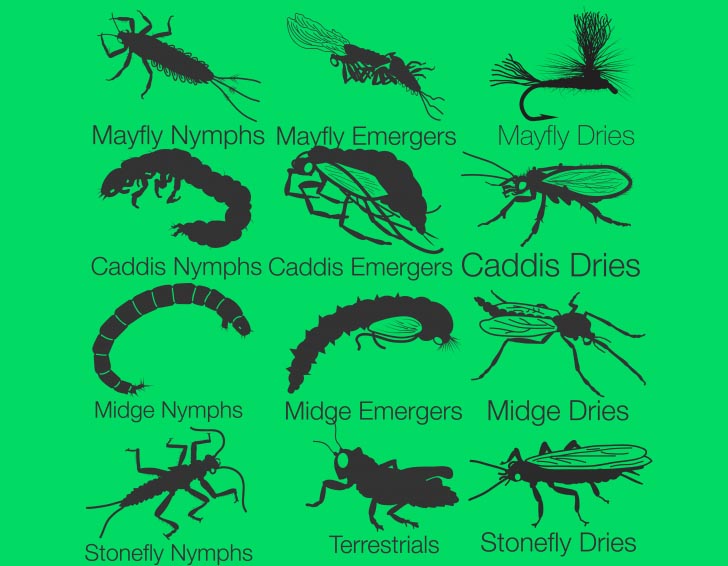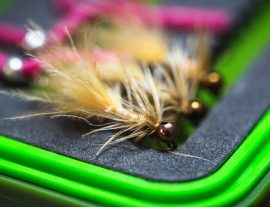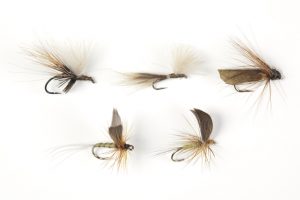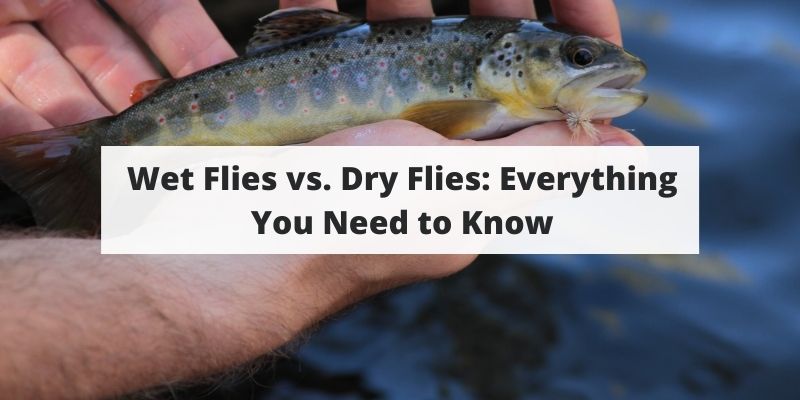Designed to mimic insects, crustaceans, eggs, worms and small fish, fly fishing flies come in a variety of shapes, sizes, colors, and patterns, each created to mimic a different part of a fish’s diet. Fly fishermen, when approaching a new stretch of water, have to learn to survey the area, assess the conditions, and choose the type of fly best suited for the job. While thousands of designs exist, making it a challenge for even experienced anglers to learn the names of them all, most fly fishing flies fit into one of two key categories: wet flies or dry flies.
In this guide, you will learn everything you need to know about wet and dry flies, types of each category, what they are used for, and how to use them to successfully fly fish in any conditions.
Quick Navigation:
What Is A Fly? | Wet Flies | Wet Flies Vs Streamers | Dry Flies | Dry Vs Wet Flies | Choosing The Right Fly
If you are new to fly fishing, you may want to check out our beginner’s guide to fly fishing before continuing on.
What Is a Fly?
A ‘fly’ is a type of bait designed to resemble insects, small fish, and other critters eaten by fish hunting at – and just below – the surface of the water. While commercially available in thousands of varieties, many fly fishers still prefer to tie their own flies, meticulously wrapping thread, feathers, fur, beads, and other materials around fishing hooks to create super-realistic and lightweight representations of fish food. When cast correctly, flies hit the water, or flow through the water, like a semi-aquatic insect, an injured bug, or a small critter getting its bearings, a tantalizing sight for any fish on the hunt for a tasty snack.
Handmade by craftspeople around the world for centuries, tying flies is a complex and highly technical practice not easily accomplished by amateurs. A skill often inherited by multi-generational anglers or learned through years of practice by only the most dedicated fly fishermen, most people today purchase their flies pre-made from bait and tackle shops.
When purchasing flies – or looking up patterns to tie your own – you will come across a few key types of flies: dry flies, wet flies, streamers, nymphs, and flies intended for specialty use (i.e. saltwater fly fishing). The two broadest categories are dry flies and wet flies, and knowing how to distinguish between the two and judge which is most appropriate for the job will help make your fly fishing trips as fruitful (or fishful?) as they are fun.
What Is A Wet Fly?
Wet flies are designed to be presented to fish below the water’s surface. Often, wet fly patterns include a weighted component to aid in the fly sinking in the water column. This component is called a “bead head”. The bead functions as a weight, to allow the fly to sink faster in the water column. When fishing deep, or fast water, it is often necessary to utilize a fly with weight, or to fish with added weight on your line to present your flies at the proper depth. On the contrary, shallow, or slow water may require the angler to use a wet fly without a bead as this bead could spook the fish, or cause the fly to sink too rapidly.
Wet flies look like insects in various stages (i.e. nymphs and larvae), fish eggs, crawfish, leeches, small fish, and other small creatures that might appeal to a fish. In some cases, wet flies are designed to skim as close to the bottom as possible, while others are carefully constructed, and presented by the angler to sit a few centimeters below the surface.
Beginner and novice fly fishermen favor wet flies for their ease of use since wet flies are used to catch fish that are feeding below the surface. Fishing in deeper waters often requires less experience and technique (not always) since fish feel safe in the murky depths and are less likely to be spooked by a false movement or splashing water. Since learning to cast with a
Many anglers will tell you, and be right, when they say that fish are only eating along the surface a small portion of the time, but are nearly always feeding below the surface. That often means, that in situations where no fish are surfacing, the only way to catch fish, would be to utilize wet flies.
Even experienced fly fishers often prefer using wet flies for a relaxing day on the stream, or to help them guarantee a more bountiful catch. Fish – even those that frequently feed at the surface – find most of their meals below the water surface, so using a wet fly increases the chances that a fish will see and react to your fly. Additionally, wet flies are often used as a bottom fly in conjunction with a wet fly (see more on this later).
Wet Fly Materials
Wet flies are designed to look like a fish’s natural diet, and therefore, different flies utilize different materials and fly structures to mimic insects at multiple stages of a life cycle. The below graph helps anglers to understand this.
Nymphs are often at the bottom, while emergers are attempting to emerge from the water to begin the next stage of life. This means fish naturally expect to see them higher up in the water column, and potentially just below or at the surface. Dry flies mimic insects ready to fly away, or insects that have landed on the water’s surface.
Wet Fly Bug Lifecycle & Entomology

Bug Entomology And Lifecycle Diagram
Wet Flies vs. Streamers: What Is a Streamer?
Sometimes considered their own category, streamers are technically a type of wet fly designed to imitate larger prey such as baitfish. One of the largest types of fly, streamers can sink deep below the surface and can be allowed to drift naturally with the current or actively fished to attract predatory fish (stripping in line, or swinging through the current). One way to identify a streamer in a tackle box full of wet flies is to look for weighted beads or eyes mounted at the front end (the head) of the fly. Streamers can be fished in much the same way as traditional wet flies, though they may be more difficult to cast due to their weight.
Streamer Examples:

Wooly Bugger streamer
Most Common Types of Wet Flies
Because wet flies are the most popular type of fly, they come in a huge variety of types and patterns. Signature design elements of wet flies include married wings, natural/neutral colors, fuzzy hackles, bead heads, and streaming tails. Of course, there is a huge variety of styles, so just about every color and size is possible. Some common and popular wet fly patterns include:
- Prince Nymph
- Zebra Midge
- RS2
- Wooly Bugger
- WD-40
- San Juan Worm
- Pheasant Tail Nymph
- Copper John
Wet Fly Examples

Wet Fly Examples
Dry Flies
Dry flies are designed to sit atop the surface of the water and made to mimic insects that are emerging to fly away, or insects that have landed on the surface of the water. In many cases, dry flies may be designed to resemble the adult version of wet flies, which may be the larval or nymph stage of semi-aquatic insects, whereas other dry flies are made to seem like injured or trapped terrestrial, insects (grasshopper, beetle, etc). Lightweight enough to not break the surface tension of the water, dry flies may create small ripples to attract fish, but otherwise tend to disturb the water less than wet flies.
Fishing with dry flies can be more challenging than fishing with wet flies, and for novice or beginner anglers, learning the proper casting technique can be a frustrating process. When fishing with wet flies, there is time between when the bait hits the water and when the fish will first notice the fly. Because the fish are deeper in the water, they are less likely to be spooked by splashing or a badly timed cast. When fishing with dry flies, there is often very little margin for error, since you’ll be targeting fish willing to feed at the surface of the water.
Despite being more technically difficult, dry fly fishing is sometimes more exciting than wet fly fishing, since you get to witness all the action right at the surface of the water.
Dry Fly Materials
Featuring more minimal bodies and more buoyant materials than wet flies, dry flies are typically made from a combination of thread, feathers, and fur. To help the flies stay above water, some may be coated in a chemical flotant applied by the angler, which penetrates deep into the fibers of the flies and helps to make them resistant to absorption.
Most Common Types of Dry Flies
Like wet flies, dry flies come in a wide variety of shapes, sizes, and designs, though some have proven more effective and become more popular than others. To identify dry flies in a tackle box, look for small flies featuring bushy wings and narrow bodies. Some common dry fly patterns include, but not limited to:
- Blue Winged Olive
- CDC Midge
- Chernobyl Ant
- Elk Hair Caddis
- Griffith’s Gnat
- Grasshopper variations
- Mayfly
- Parachute Adams
- Royal Wulff
- Sparkle Dun
- Stimulator
Dry Fly Examples

Fly Fishing Hook Sizes
Most wet and dry flies for freshwater fishing are outfitted with hooks sizes 12-20, with 20 being the smallest and most delicate. The small size of dry fly hooks makes them particularly challenging to tie, though some anglers enjoy the challenge of creating fine details on a tiny base. You will find larger dry flies however. For example, some grasshopper patterns will be larger to mimic larger grasshoppers.
As a beginner looking to understand flies, reading about sizes may be a bit confusing, especially when it comes time to choose the proper size for your fishing situation. Selecting the proper size is all about understanding what the fish are feeding on. Some situations may require small flies to fool the fish, while others may require or allow for larger flies. The closer your fly size is to what the fish are currently feeding on, the greater your odds will be.
Dry Fly vs. Wet Fly: Key Differences & Comparison
An easy way to remember the difference between dry flies and wet flies is to remember this: dry flies stay dry, wet flies get wet!
Dry vs. Wet Fly Rigs
Used in different ways and for different purposes, dry and wet flies require slightly different rigging. In some cases, when using multiple flies, both wet and dry flies may be used in combination.
Single Wet Fly
A standard wet fly rig will include one fly at the end of your line, sometimes accompanied by an indicator or bobber several inches or feet above the fly to show you where your bait is hiding, and alerting anglers when your fly has hit bottom, or a fish has taken your fly. Single wet fly rigs are the easiest for beginners to fish on since they are easier to cast than 2 or 3 fly rigs, and are less likely to get tangled. Depending upon the depth and speed of the water, anglers may add weight to the line to assist the fly in sinking.
Double Wet Fly
Fishing with a double wet fly rig can allow you to take advantage of two different columns in the stream simultaneously. Double wet fly rigs typically include a bottom fly (sometimes a nymph or a streamer) accompanied by a similar fly or something that could be found closer to the surface (like an emerger of some sort). Double wet flies can be rigged in several ways, but the most basic is tying the bottom section of tippet directly to the hook of the top fly. Like single wet fly rigs, double wet fly rigs may also utilize an indicator and weights.
A double rig may double your chances of catching a fish on a single drift, which is why many anglers always use double or triple fly rigs. It is worth noting that the more flies you add, the easier it is to get tangles. So beginners may often stick to single or double fly rigs in simple casting scenarios.
Single Dry Fly
Like a single wet fly rig, a single dry fly rig includes a single fly tied at the end of the line. This is the most common type of rigging for dry fly fishing. Anglers will frequently tie two dry flies on as well to increase the odds of a fish going after one of them. This is the simplest type of rig.
Dry Dropper Rigs
Dry dropper rigs combine the best of both worlds, utilizing a dry fly in combination with a wet fly – typically a nymph. Dry dropper rigs consist of a wet fly at the end of the line, and a dry fly a few feet above it. When submerged, the wet fly behaves in much the same way as it would on a single wet fly rig. Above the submerged wet fly, the dry fly sits atop the water, behaving the same as it would on a single dry fly rig. Should a fish go for your wet fly, the dry fly on the water’s surface acts as your indicator.
These are one of the most versatile rigs to catch fish in all types of water. It becomes an important asset for many anglers.
Wet Fly Fishing Techniques
Fishing with wet flies may be slightly less thrilling to watch, but you are often increase your odds by fishing wet flies. You’ll find anglers fishing wet flies in various different ways:
- Dead drifting below an indicator
- Swinging streamers across the river at about a 45 degree angle
- Stripping streamers through the water downstream, or in still water
- Euro, Czech, or tight line nymphing without an indicator
- Sight fishing with wet flies (simply trying to spot the take)
- Downstream nymphing / swinging
We could go into these techniques for hours, but we just wanted to point these out so you can do additional research. We highly recommend checking the videos out on some of these techniques below.
Dry Fly Fishing Techniques
Many fly fishers think of dry fly fishing as the most exciting type, since they get to witness all the action right at the surface of the water. Seeing a fish strike and grab onto your fly right before your eyes can be a real thrill, even if the process takes longer than fishing for more abundant fish not willing to rise to the surface. There are various key things that fisherman need to pay attention to when dry fly fishing:
- Casting from an appropriate position to get proper drift
- Mending to get proper drift
- Utilizing the right fly and matching the hatch
You’ll want to view our video section below on these topics.
Choosing the Right Fly
Now that you know the difference between wet and dry flies, and understand how they are used, it’s time to learn how to select the right fly for your needs. Anglers should always head to the river with a variety of dry flies, wet flies, and streamers, so that they can be prepared to just about any situation. Here’s what you need to know to choose the right fly on your next fishing trip:
Key Considerations
Here are some key considerations for choosing a fly once you get to the water.
The Water You Are Fishing
Is the water shallow? Deep? Fast moving? Slow moving? What sections have drop offs? Sandy bottom, rocky bottom, or gravel bottom? Are there areas where fish can take cover? Are likely feeding? Can rest from the current?
Are there places where you can stand to get a quality cast, and good drift without spooking the fish?
Taking note of all of this will enable you to:
- Select a proper position and method for covering the water in front of you.
- Select the proper depth, weight, or fly based on the situation.
- Methodically work the water to cover areas where fish might be holding and feeding.
Bugs Hatching
Are there bugs hatching? Can you take a scoop of sand or turnover a rock to see what organisms are present? If you do this and find a specific nymph or midge, you likely can catch fish on a fly that closely mimics that. Do you see bugs hatching in the water or flying away? Doing this can allow you to properly select flies.
Can You Spot Fish Feeding?
Can you see fish? If so, are they feeding, and what are they feeding on? Are they feeding at the bottom? In the middle of the water column? Just below the surface? Or are they sipping on flies on top of the water? If you can see fish, you may be at an advantage to determining how to catch them.
Season & Water Temperature
Seasons and water temperatures can dictate bug hatches, water levels, fish movement, and feeding. Knowing if the water is warm or cold can give you insights that can help you select the right flies and depths. Winter or colder water temps often lead to low water, and less active fish. They are likely feeding on smaller midges and nymphs, and therefore smaller flies, thin tippet, and perfect drifts may be necessary.
Dry & Wet Fly Fishing Videos
Here is a fantastic video explaining dry fly fishing and emerger fishing. This is a must watch for any beginner to intermediate angler.
For wet fly fishing, this is an absolute must watch:
And here is your must watch video for fishing streamers:
Max DesMarais is the founder of hikingandfishing.com. He has a passion for the outdoors and making outdoor education and adventure more accessible. Max is a published author for various outdoor adventure, travel, and marketing websites. He is an experienced hiker, backpacker, fly fisherman, backcountry skier, trail runner, and spends his free time in the outdoors. These adventures allow him to test gear, learn new skills, and experience new places so that he can educate others. Max grew up hiking all around New Hampshire and New England. He became obsessed with the New Hampshire mountains, and the NH 48, where he guided hikes and trail runs in the White Mountains. Since moving out west, Max has continued climbed all of the Colorado 14ers, is always testing gear, learning skills, gaining experience, and building his endurance for outdoor sports. You can read more about his experience here: hikingandfishing/about

